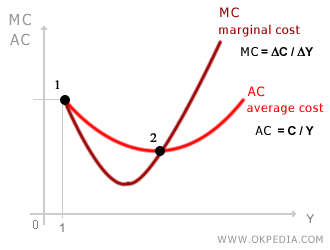Difference Between Average Cost and Marginal Cost
The difference between average cost and marginal cost stems from the distinct ways these two economic indicators are measured.
The average cost is calculated by dividing total cost by the total quantity of output. For example, if total costs amount to 1,000 and 500 units are produced, the average cost is 2 (1,000 / 500). In this case, the variables used are absolute values, meaning they reflect total quantities.
AC = C / Y
In contrast, marginal cost measures the additional cost incurred when production increases by one more unit. For instance, if producing two additional units results in an extra cost of 5, then the marginal cost is 2.5 (5 / 2). Unlike average cost, marginal cost relies on relative values, focusing on small, incremental changes rather than total figures.
MC = ΔC / ΔY
Since they are based on different measurement approaches, these two cost concepts are fundamentally distinct.
How Costs Are Considered in Average and Marginal Cost
Another key distinction between marginal cost and average cost lies in the type of cost they account for.
Average cost is derived from total cost (C), which includes both fixed and variable costs. As a result, the average cost curve reflects both cost components as absolute values.
Marginal cost, on the other hand, considers only variable costs because fixed costs remain constant regardless of output levels. Since fixed costs do not change with production, their marginal variation is always zero. Consequently, the marginal cost curve exclusively captures changes in variable costs as a relative measure.
For this reason, the average cost curve and the marginal cost curve do not overlap.

At lower production levels, unit fixed costs are relatively high but decrease as production scales up. Meanwhile, unit variable costs tend to rise with increased output. The average cost curve represents the combined effect of these two trends, whereas the marginal cost curve reflects the rate at which variable costs accelerate.
When Marginal Cost Equals Average Cost
Marginal cost intersects with average cost at two key points. The first occurs when the very first unit of output is produced.

The second intersection happens in the rising phase of the marginal cost curve, where variable costs increase more rapidly than average costs.
